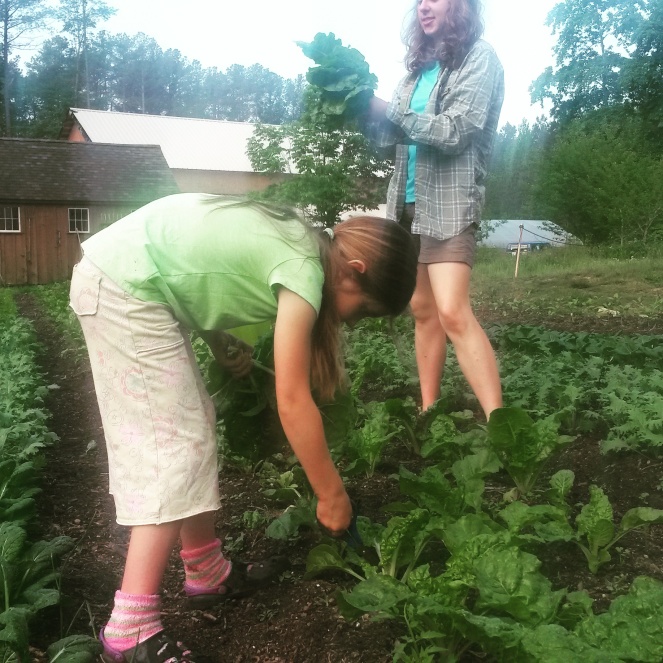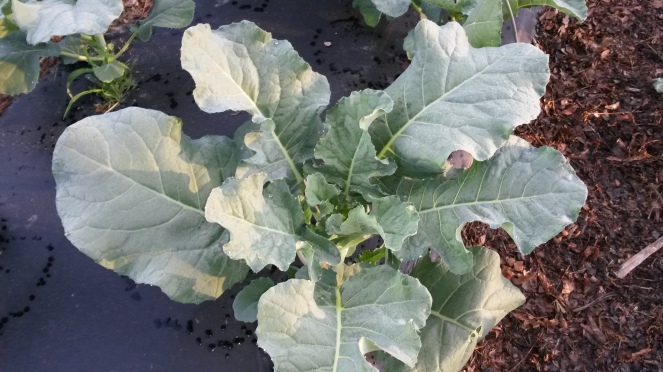What an amazing turn out we had for our Farm Day * Plant Sale * Farm Tour last Saturday! Thank you immensely to everyone who traveled our way and spent part of their weekend with us. We really love it when the community members that we grow food for descend upon this little piece of earth to look and listen and ask questions. And suck on some honey-pops and bring home plants for your garden!

{Speaking of the honey pops: We made 75 of them and thought that would be plenty. Thank you for the number of visitors exceeding our expectations and our apologies for selling out of the honey-pops before the end of the afternoon!}
We like to help parents succeed at getting their children to eat a lot of vegetables, so today we are sharing what our family members’ plates look like and how we handle this subject.

Our kids are 8, 6, 3, and infant. Our oldest turned 8 this week. Yes, we had cake. She chose banana-bread-cake and we topped it with whipped cream (we whipped it ourselves, and did not add sugar. This is how she asks for it.) We don’t always have dessert, but if we do, it is certainly a rule that our kids have to eat their dinner vegetables and protein first.

At each dinner and most lunches, we try to offer 3 or 4 vegetable choices and tell the kids they have to choose 2 or 3 of them. We use a 50-25-25 rule, which is that vegetables need to cover 50% of a person’s plate, with protein and carbohydrates covering 25% each. (Our fats tend to be incorporated into each of the other three calorie types through dressing, sauce, toppings, fat on the protein, etc. We eat lots of good, healthy fats.)

What does this look like for various menus? Salad and microgreens are easy vegetables to serve and we involve the kids in making dressings to top the greens. We are in a constant rotation between olive-oil-balsamic-vinaigrette, honey-mustard-vinaigrette, and a homemade ranch (mayo-yogurt-herbs). We love a simple saute of greens (hearty mix, kale, collards, spinach, beet greens, etc.) cooked up with some fat, salt, and vinegar. The kids love this as well, and often their three vegetables are salad greens, microgreens, and cooked greens.
Other vegetable options change with the seasons. Simple sliced veggies, when they taste as good as ours, are easy: Cucumbers, Tomatoes, sweet Peppers. Spring and fall radishes they love in a salad like this one with soy sauce or this one with honey mustard. Or even simpler: Tossed with a mixture of olive oil, rice vinegar, honey, and sea salt. No greens added – just radishes and sauce. We are all huge fans of alliums (onions, garlic, leeks…) in a saute with butter (or whatever fat you prefer) and salt. This makes everything better: cooked greens, pan-cooked carrots, pan-cooked radishes, turnips, etc. We also like to do a lot of stir-frying and mix the vegetables in with the protein and fat, as well as shamelessly putting a lot of veggies in with scrambled eggs. (Finely chopped greens, root vegetables, pepper and tomatoes in season, etc.)

They also are allowed to put a sauce on their cooked vegetables – like barbecue sauce, hoisin sauce, homemade ranch, soy sauce, rice vinegar, balsamic vinegar, etc. They each have their preference.
If one of our kids is resisting vegetables, we serve the vegetables first and have a rule that they have to be eaten before the protein and carbohydrates are served. This works. Not always immediately, but our rule is that if dinner is not eaten as served, it is served again for breakfast. This really works. We are on our third three-year-old experience and it is sometimes painful. Three year olds, in our experience, can really resist and be quite stubborn. But our older two kids, who have already “graduated” from this system, have a clear understanding of the parameters. Vegetables get eaten. They know how to serve a healthy, well rounded plate of food. They sometimes have dinner leftovers for breakfast. We feel good about their eating and their perspective on healthy food, as well as their perspective on food that is eaten sparingly as treats. What we are doing isn’t magic, but it also isn’t always easy. Good luck and ask us for more information if you need help!

And a note about Bugs: We have a good number of new CSA members this year and whenever people are new to eating local, organic greens there can be a learning curve about bugs as they relate to the vegetables you pick up from us. Notably, our inability to remove each and every one from your food. We don’t broadcast kill bugs for many reasons, including the negative side-effect of killing beneficial insects along with the troublesome pests. We double (and sometimes triple) wash all of our bagged greens, but sometimes little insects or even little spiders cling on to the leaves through all of our washing and sorting process. In bunched greens or heads (lettuce, cabbage, broccoli…) there are certainly some bugs buried down in the vegetable matter that we can’t remove. On the large, industrial ag scale we have been told that vegetables are gassed or exposed to some sort of radiation post-harvest, killing the bugs but not the vegetables, which allows the bugs to fall out. We don’t do this. 🙂 So….sometimes you the consumer get to have an experience with a bug from our farm! Try your hardest to embrace it and understand that it is a product of your food being grown in harmony with nature. Wash the vegetables thoroughly yourself to be sure it is ready for eating. And if you are traumatized by a bug encounter in our vegetables, just let us know and we will do what we can to replace the item.
Recipe Suggestions: (which we catalog weekly on our Recipe Page)
Radishes – Remember you can roast them. Or slice and serve cold tossed with homemade ranch dressing. (We always substitute yogurt from Old Church Creamery instead of using the sour cream it calls for.)
Garlic Scallions – use like scallions (all of the tender light part), getting the garlic taste. Use raw in dressings or in salad, or saute up for anything (eggs, pasta salad, stir fry, salad dressing/topping.) Use the dark green tops in any soup/stock. (We keep them in a bag in the freezer with other stock ingredients until the bag is full and we have enough to make a pot of stock from these veggies and bones. Then that broth is delicious alone or can be used to cook rice or beans, making them more flavorful and nutritious.)
Kale – In addition to last week’s massaged kale salad suggestions (archived here), you can always simple slice the kale into thin ribbons and add any salad dressing. We love a mixture of balsamic vinegar, olive oil, a touch of honey, plus sea salt, sharp cheddar chuncks, pecans, and raisins.
Collards or Chard or Hearty Mix – treat just like Kale, above, or slice into ribbons and braise in buttery veg or chicken broth and serve with any protein (beans, tofu, or meat).
Available for Market Share CSA members to choose from this week: Arugula, Chard, Collards, Cucumbers, Chard, Garlic Scallions, Hearty Mix, Lettuce Mix, Little Gem Lettuce, Microgreens, Radishes, Salad Spinach …and Pepper Jelly, Fermented Jalapenos, naturally leavened Hearth Baked Bread. PLUS Plants: Cilantro, Dill, Basil, Parsley, Cucumbers, Yellow Summer Squash, Zucchini, Tomatoes, Eggplant (variety details on ordering page).
2015 Market Share CSA Members: Reserve your selection online to pick up on Saturday, May 16 at our farm, at the Brandermill Green market, or at the South of the James market.
**Anyone may order select goods from us, through Fall Line Farms, Richmond’s online farmers’ market. You can use discount code “broadfork” to earn a complimentary 6 month subscription.
Enjoy ~ Janet, Dan, and the rest of the Broadfork crew
(Want to learn more about us? Visit us on Facebook, Instagram, or Twitter.)
